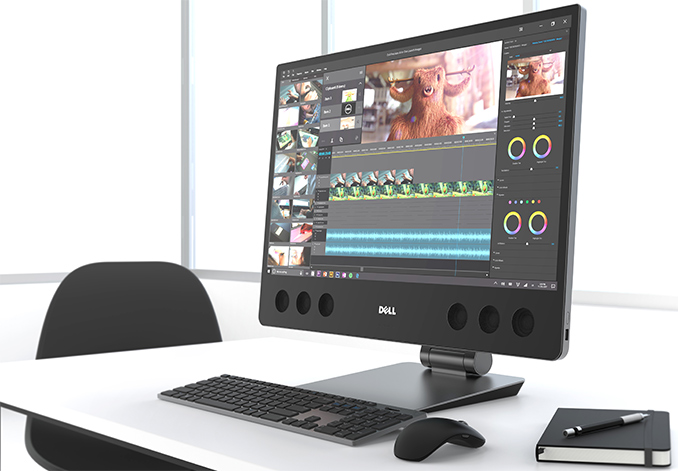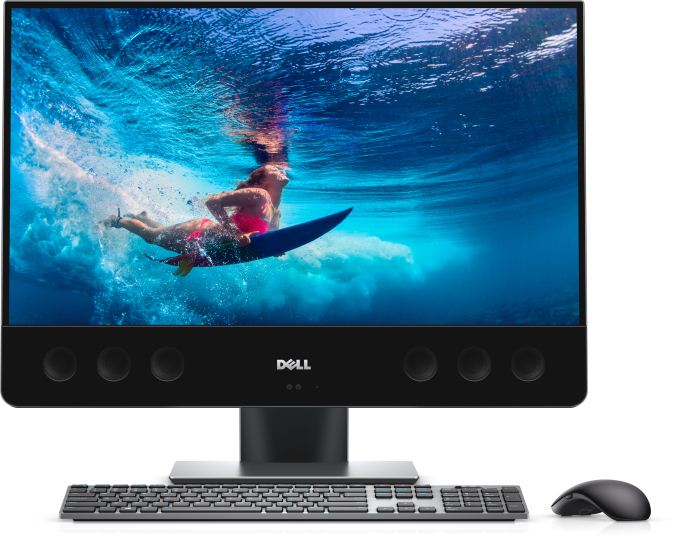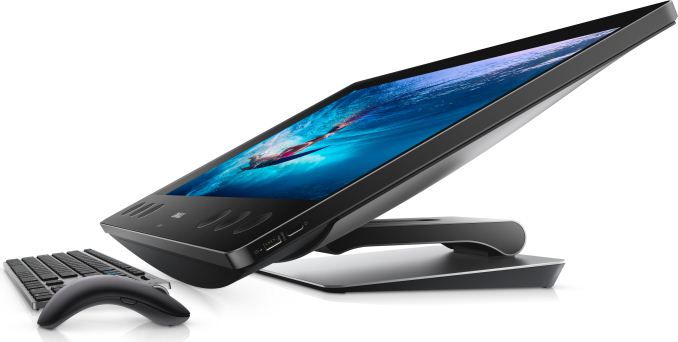Dell Launches 'VR Ready' XPS 27 AIO: 4K, Core i7-7700, Radeon RX 570, 10 Speakers
by Anton Shilov on May 27, 2017 11:00 AM EST
Dell has launched a new version of their XPS 27 all-in-one gaming PC. The VR Ready flavor of the XPS 27 has the same 4K display and the same 10-speaker audio sub-system as the latest iteration of the large XPS AIO, but is powered by a more powerful CPU from Intel along with AMD’s discrete Radeon RX 570 graphics board.
AIO PCs have existed for decades, with their continued popularity fueled by their compact, desk-sized footprint. In the recent years demand for higher performance and even gaming-grade all-in-ones increased noticeably, and manufacturers started to offer AIOs with rather powerful hardware. In fact, in early 2016 several PC makers even introduced Mini-ITX-based AIOs with top-of-the-range discrete graphics cards aiming at customers seeking for maximum performance.
Dell’s new XPS 27 with the VR Ready badge are designed for gamers with average requirements for performance. The systems are still considerably more powerful than their predecessors launched earlier this year are because they do not use integrated or mobile graphics, but rely on AMD’s Radeon RX 570 (2048 stream processors, 128 texture units, 32 ROPs, 256-bit memory bus, etc.) graphics adapter with 8 GB of memory. Meanwhile, the key feature of the latest XPS 27 remained intact: the audio sub-system with 10 speakers (six on the front, two down firing and two radiating) designed to enable surround sound without using bulky external audio equipment.
The VR Ready versions of the Dell XPS 27 are based on Intel’s Core i7-7700 CPU as well as the H170 PCH. By default, the systems are equipped with 16 GB of DDR4-2133 memory, but that is upgradeable to 64 GB. As for storage, the PCs have one M.2 slot (PCIe 3.0 x4) as well as two 2.5” bays for HDDs or SSDs, all accessible to the end user. When it comes to connectivity, the Dell XPS 27 feature 802.11ac Wi-Fi, Bluetooth 4.x, a GbE port, five USB 3.0 Type-A headers, one HDMI output, one DisplayPort 1.2, two Thunderbolt 3 ports (USB Type-C), an SD/MMC card reader, a 720p webcam with an IR sensor for facial recognition, a microphone and so on. Overall, there are plenty of ports to plug-in additional peripherals, including various VR gear.
| Dell XPS 27 7760 'VR-Ready' Specifications | ||
| Non-Touch | Touch-Enabled | |
| Display | 27" IPS with 3840×2160 resolution 1.07 billion colors, 100% Adobe RGB, 350-nit brightness |
|
| CPU | Intel Core i7-7700 4C/8T, 3.6/4.2 GHz 8 MB cache 65 W |
|
| PCH | Intel H170 | |
| Graphics | AMD Radeon RX 570 with 8 GB of GDDR5 2048 stream processors, 128 texture units, 32 ROPs, 256-bit memory bus |
|
| Memory | 16 GB of DDR4-2133 (four slots in total, upgradeable to 64 GB) | |
| Storage | 2 TB HDD 32 GB caching SSD (M.2) |
512 GB SSD (PCIe 3.0 x4) |
| Wi-Fi | IEEE 802.11ac Wi-Fi + BT 4.x | |
| Ethernet | GbE | |
| Display Outputs | 1 × HDMI 1 × DP 1.2 |
|
| Audio | 10 speakers 1 × audio out |
|
| USB | 5 × USB 3.0 Type-A (5 Gbps, one supports PowerShare) 2 × Thunderbolt 3 (USB Type-C) |
|
| Other I/O | 720p webcam with RGB and IR sensors SD/MMC card reader |
|
| Dimensions | 625 mm / 24.6" × 435 mm / 17.1" × 80 mm / 3.16" | |
| Stand | regular | articulating stand |
| OS | Windows 10 Home | Windows 10 Home or Pro |
All Dell XPS 27 AIO PCs are constructed of CNC-machined aluminum and come with UltraSharp displays with a 4K (3840×2160) resolution. Meanwhile, computers with touch-enabled screens also feature articulating stands for added convenience. The stand comes at an extra cost, so some gamers may prefer to install a larger SSD and/or more memory and skip the touch option.
At present Dell offers two versions of the VR Ready XPS 27 featuring Intel’s Core i7-7700 CPU and AMD’s Radeon RX 570 GPU, but different storage configurations and touch support. The model with a 2 TB HDD and 32 GB caching SSD costs $1999.99, whereas the model with a 512 GB PCIe SSD, a touchscreen display with articulating stand and optional Windows 10 Pro comes at $2,649.99.
Related Reading:
- ASUS Launches the Zen AiO ZN270IE: A 27-inch Full HD Core i7 All-In-One
- ASUS Designo Curve MX34VQ Incoming: 34" Ultrawide Curved Display with Qi Charging
- The Microsoft Surface Studio Review
- Microsoft Announces the Surface Studio: 28-inch AIO with Touch, Pen, 4500x3000, Skylake, GTX 980M
- CES 2016: 34-inch 3440x1440 AIO Hands-On at GIGABYTE
Source: Dell




_thumb.png)
_thumb.png)












29 Comments
View All Comments
Hul8 - Saturday, May 27, 2017 - link
I wonder if the touch display works with stylus pens. If that is the case, this kind of a computer would make for a good computer for artist types.Yuriman - Saturday, May 27, 2017 - link
Ten one-inch speakers doesn't impress me all that much.damianrobertjones - Sunday, May 28, 2017 - link
It's not the size... it's the quality. Of course if you can have both... .tipoo - Sunday, May 28, 2017 - link
I mean, it's an all in one, they don't go much bigger.Lolimaster - Sunday, May 28, 2017 - link
If you can put a i7 7700 you can put a Ryzen 5 1600 or Ryzen 1700 which murder that outdated cpu for even less price. When will OEM's learn to just jump the AMD monster to increase their own profits.ajp_anton - Sunday, May 28, 2017 - link
For games, and most single-threaded (or not well-multithreaded) tasks, the i7-7700k still murders everything else. Ryzen shines when it comes to threading, and also price (can put the money on a better GPU), but if money is not an issue, get the i7-7700k for games.Lolimaster - Sunday, May 28, 2017 - link
Still the same excuse, that "huge difference" is 10% and in games if you got a 1080ti at peasant 1080p.You like having 10% while losing 90% of extra cpu resources on a platform that will receives upgrades till 2020, and in just 2 months increades it's performance by 5-10% by bios/agesa updates?
Makes no sense to me.
Lolimaster - Sunday, May 28, 2017 - link
Want a gaming cpu? Ryzen 5 1500X, 95% of the i7 7700 is gaming1500X $190
i7 7700 $320
Pay more to get 5-10fps more or 10% with high end gpu. Good thinking... keep being scammed by intel.
Zak - Sunday, May 28, 2017 - link
AMD fanboyism is really weird, though gets cute at times.Meteor2 - Sunday, May 28, 2017 - link
True.The CPU which gives higher FPS than anything else when paired with a 1080 Ti is the Intel 7700K. Maybe that will change as developers learn to exploit DX12 but today that's the reality.
No question CPUs like the 1500X and 1600X are superb value, and I think the 1600X is the best value and best-balanced CPU going, but the 7700K *is* king for gaming when you're not constrained by your GPU.